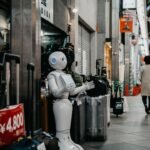Generative AI represents a transformative leap in the field of artificial intelligence, characterized by its ability to create new content, designs, and solutions based on learned patterns from existing data. Unlike traditional AI systems that primarily focus on classification or prediction, generative AI employs sophisticated algorithms, such as Generative Adversarial Networks (GANs) and Variational Autoencoders (VAEs), to produce original outputs that can range from text and images to music and even complex simulations. This technology has gained significant traction in recent years, fueled by advancements in machine learning, increased computational power, and the availability of vast datasets.
As a result, generative AI is not merely a technological novelty; it is a catalyst for innovation across various sectors. The implications of generative AI extend far beyond the realm of technology. Businesses are beginning to recognize its potential to drive efficiency, enhance creativity, and foster new forms of engagement with customers.
Moreover, the ability to tailor outputs to specific user preferences opens up new avenues for personalization, allowing companies to forge deeper connections with their audiences. As we delve into the various applications of generative AI, it becomes evident that its impact is profound and multifaceted, reshaping industries and redefining the boundaries of what is possible.
Key Takeaways
- Generative AI is a powerful technology that can drive business innovation by creating new and unique content.
- Product design can be enhanced through the use of generative AI, allowing for the creation of innovative and personalized products.
- Generative AI can improve customer experience by creating personalized recommendations and enhancing interactions with customers.
- Operations and efficiency can be improved through the use of generative AI, allowing for automation and optimization of processes.
- The future of business innovation with generative AI is promising, with potential applications in healthcare, finance, and creative content generation.
How Generative AI is Driving Business Innovation
The integration of generative AI into business processes is revolutionizing how companies innovate and compete in the marketplace. One of the most significant advantages of generative AI is its capacity to analyze vast amounts of data and generate insights that would be impossible for humans to discern in a reasonable timeframe. This capability allows businesses to identify emerging trends, optimize product features, and even predict customer behavior with remarkable accuracy.
For instance, companies can leverage generative models to simulate various market scenarios, enabling them to make informed decisions about product launches or marketing strategies. Moreover, generative AI fosters a culture of experimentation within organizations. By providing tools that can rapidly prototype ideas or create variations of existing products, businesses can test hypotheses and iterate on designs more efficiently than ever before.
This iterative approach not only accelerates the innovation cycle but also reduces the risks associated with new product development. Companies that embrace generative AI are better positioned to respond to market changes and customer demands, ultimately leading to a more agile and resilient business model.
Real-World Example 1: Using Generative AI for Product Design
In the realm of product design, generative AI has emerged as a game-changer, enabling designers and engineers to explore a vast array of possibilities in a fraction of the time it would traditionally take. For example, Autodesk’s Fusion 360 utilizes generative design algorithms to help engineers create optimized structures based on specific constraints such as weight, material type, and manufacturing methods. By inputting these parameters into the software, users can generate multiple design alternatives that meet their criteria, allowing them to select the most efficient and innovative solution.
A notable case study involves Airbus, which employed generative design techniques to develop lightweight components for its aircraft. By using generative AI, Airbus was able to create complex geometries that traditional design methods would have overlooked. The resulting components not only reduced weight but also improved fuel efficiency, showcasing how generative AI can lead to significant advancements in engineering and manufacturing processes.
This approach not only enhances product performance but also contributes to sustainability efforts by minimizing material waste.
Real-World Example 2: Enhancing Customer Experience with Generative AI
Generative AI is also making waves in enhancing customer experience across various industries. Companies are increasingly utilizing this technology to create personalized interactions that resonate with individual preferences. For instance, Netflix employs generative algorithms to analyze viewer behavior and generate tailored content recommendations.
By understanding what types of shows or movies a user enjoys, Netflix can suggest new titles that align with their tastes, thereby increasing viewer engagement and satisfaction. In the retail sector, brands like Sephora have harnessed generative AI to enhance the shopping experience through virtual try-on features. By using augmented reality combined with generative models, customers can visualize how different makeup products will look on their skin before making a purchase.
This not only empowers consumers with more information but also reduces return rates by ensuring that customers are satisfied with their choices prior to buying. Such applications illustrate how generative AI can transform customer interactions into more engaging and personalized experiences.
Real-World Example 3: Leveraging Generative AI for Marketing and Advertising
The marketing landscape is undergoing a significant transformation thanks to generative AI’s ability to create compelling content at scale. Brands are increasingly turning to AI-driven tools to generate advertisements, social media posts, and even entire marketing campaigns tailored to specific audiences. For example, companies like Persado utilize natural language generation algorithms to craft persuasive marketing messages that resonate with target demographics.
By analyzing language patterns and emotional triggers, these tools can produce copy that drives higher engagement rates. Additionally, Coca-Cola has experimented with generative AI in its advertising efforts by creating personalized video ads that adapt based on viewer preferences. By leveraging data analytics alongside generative models, Coca-Cola can deliver unique advertisements that speak directly to individual consumers’ interests and behaviors.
This level of customization not only enhances brand loyalty but also maximizes the effectiveness of marketing spend by ensuring that messages reach the right audience at the right time.
Real-World Example 4: Improving Operations and Efficiency with Generative AI
Generative AI is proving invaluable in optimizing operations across various sectors by streamlining processes and enhancing efficiency. In manufacturing, for instance, companies are employing generative algorithms to improve supply chain management and production scheduling. By analyzing historical data and predicting demand fluctuations, businesses can optimize inventory levels and reduce waste.
A prime example is Siemens, which has integrated generative AI into its manufacturing processes to enhance production planning and resource allocation. In logistics, firms like DHL are utilizing generative AI for route optimization. By analyzing traffic patterns, weather conditions, and delivery schedules in real-time, DHL can generate optimal delivery routes that minimize fuel consumption and improve delivery times.
This not only leads to cost savings but also enhances customer satisfaction by ensuring timely deliveries. The ability of generative AI to analyze complex datasets and generate actionable insights is revolutionizing operational efficiency across industries.
Real-World Example 5: Harnessing Generative AI for Personalized Recommendations
Personalization has become a cornerstone of modern business strategy, and generative AI plays a pivotal role in delivering tailored recommendations that enhance customer engagement. E-commerce giants like Amazon leverage sophisticated algorithms to analyze user behavior and preferences, generating personalized product suggestions that drive sales. By utilizing collaborative filtering techniques alongside generative models, Amazon can recommend items based on similar users’ purchasing patterns.
Spotify exemplifies the power of generative AI in creating personalized music playlists for its users. The platform employs machine learning algorithms that analyze listening habits and preferences to curate playlists like “Discover Weekly,” which introduces users to new music tailored specifically for them. This level of personalization not only keeps users engaged but also fosters brand loyalty as customers feel understood and valued by the service they use.
Real-World Example 6: Transforming Healthcare with Generative AI
In healthcare, generative AI is paving the way for groundbreaking advancements in diagnostics, treatment planning, and drug discovery. For instance, researchers at MIT have developed a generative model capable of predicting molecular structures for new drugs based on existing compounds’ properties. This approach significantly accelerates the drug discovery process by enabling scientists to explore vast chemical spaces quickly.
Moreover, generative AI is being utilized in medical imaging analysis. Companies like Zebra Medical Vision employ deep learning algorithms to analyze medical images such as X-rays or MRIs, generating insights that assist radiologists in diagnosing conditions more accurately and efficiently. By automating image analysis tasks, healthcare professionals can focus on patient care while benefiting from enhanced diagnostic capabilities powered by generative technology.
Real-World Example 7: Innovating in the Financial Sector with Generative AI
The financial sector is experiencing a paradigm shift as institutions adopt generative AI to enhance risk assessment, fraud detection, and customer service. For example, JPMorgan Chase has implemented machine learning algorithms that analyze transaction data in real-time to identify potentially fraudulent activities. By generating alerts based on unusual patterns or behaviors, these systems enable quicker responses to mitigate risks.
Additionally, banks are leveraging generative AI for personalized financial advice through chatbots and virtual assistants. These tools analyze customer data to provide tailored recommendations regarding investments or savings strategies based on individual financial goals. This level of personalization not only improves customer satisfaction but also empowers clients with actionable insights that enhance their financial decision-making processes.
Real-World Example 8: Using Generative AI for Creative Content Generation
The creative industries are witnessing a renaissance fueled by generative AI’s ability to produce original content across various mediums. Artists and musicians are increasingly collaborating with AI systems to explore new creative avenues. For instance, OpenAI’s DALL-E generates unique images based on textual descriptions provided by users, allowing artists to visualize concepts that may have previously been difficult to articulate.
In music production, platforms like AIVA (Artificial Intelligence Virtual Artist) utilize generative algorithms to compose original pieces based on user-defined parameters such as genre or mood. This technology enables musicians to experiment with new sounds and styles while providing inspiration for their creative endeavors. The intersection of human creativity and machine-generated content is reshaping artistic expression and expanding the boundaries of what is considered art.
The Future of Business Innovation with Generative AI
As we look ahead, it is clear that generative AI will continue to play a pivotal role in shaping the future of business innovation across diverse sectors. Its ability to generate novel ideas, optimize processes, and personalize experiences positions it as an essential tool for organizations seeking a competitive edge in an increasingly complex marketplace. The examples discussed illustrate just a fraction of the potential applications of this technology; as it evolves further, we can expect even more groundbreaking developments.
The ongoing integration of generative AI into business practices will likely lead to enhanced collaboration between humans and machines, fostering an environment where creativity flourishes alongside efficiency. As organizations embrace this transformative technology, they will not only redefine their operational capabilities but also unlock new opportunities for growth and innovation in ways previously thought impossible. The future promises an exciting landscape where generative AI continues to drive progress across industries while reshaping our understanding of creativity and intelligence itself.









